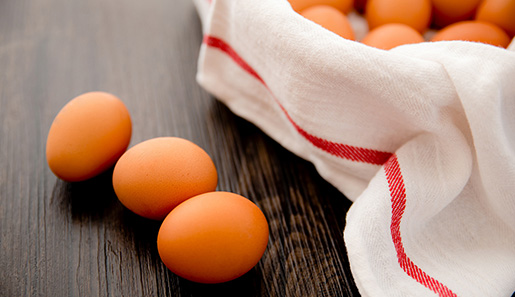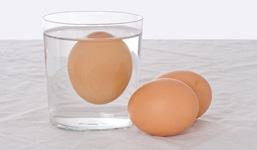 |
|
SPOTLIGHT |
|
|
|
|
|
| A Really Good Egg |
There’s nothing quite like a really fresh egg! In fact, if you compare mainland and local eggs side by side, you’ll find that local eggs have better taste and texture – not to mention that they make the perfect Loco Moco!
But success hasn’t come easy to local egg farms. Minda Takaki, farm manager of Maili Moa Farms that produces Shaka Moa eggs explains that business was initially tough for the local, family-owned company run by her husband Mark because mainland eggs were so much cheaper. But thanks to local customers who support local farmers, Shaka Moa is now going strong with more than 12,000 chickens producing well over one million eggs a year at their cage-free farm.
You may be amazed to learn that Shaka Moa eggs are on Foodland’s shelves fewer than seven days after they’ve been collected and sorted at the Waianae farm. Try them and you’ll notice a big difference!

Here are a few more interesting tidbits about these great local eggs:
|
• No cracks in the armor! After going through a machine-wash and sorting process, all Shaka Moa eggs are carefully inspected by one of the company’s nine employees. The team’s goal is to ensure that customers never have to swap cracked eggs out of their cartons.
• Happy chickens, tasty eggs! Shaka Moa eggs come from cage-free chickens. They have their own roosting boxes, a large communal outdoor area and natural light — even when they are indoors. Having the freedom to roam around enables the chickens to build stronger muscles which results in better eggs.
• Brown or White? Brown eggs come from brown chickens, and white eggs come from white chickens. Nutritionally, there’s no difference, but brown eggs are often a little bigger, have a richer taste and darker colored yolk. That may be because brown chickens are larger than white ones and eat more food. If it seems like brown eggshells are harder to crack, it’s probably because they come from younger chickens.
• Give ‘em a Break: Shaka Moa’s brown hens are retired after about two years of egg-laying. As they get older, they lay less frequently and their eggs are more fragile.
• Golden Egg: While there are many ways to crack – and eat – a Shaka Moa egg, Minda says her favorite is “fried, a little runny, in a SPAM® and egg sandwich, with ketchup and Tabasco!
|
|
|
|
| Did You Know? |
 |
 |
|
| You can tell a fresh egg from an old egg by giving it a simple “float test.” Place the egg into a glass and fill it with water. A fresh egg will sink and an old egg will float! Shaka Moa’s Minda Takaki explains, “Eggs can be kept 30 to 45 days, if properly stored in the refrigerator, but I wouldn’t eat an egg that floated!” |
|
|
|
|
 |
|
RECIPES |
|
|
|
|
|
| Oyako Donburi |
| Makes 1 Servings |
|
|
|
| This classic Japanese comfort food features local eggs and chicken, gently simmered in a flavorful broth and served over rice. The name comes from “oya” (parent) and “ko” (child)—chicken and egg! |
| INGREDIENTS |
- 1⁄4 cup onions, peeled and julienned
1 boneless chicken thigh, cut into bite-size strips
1⁄8 cup kamaboko (fish cake), cut into strips
2 tablespoons mirin
2 tablespoons soy sauce
2 tablespoons sake
2 tablespoons dashi (You can use scratch or instant. In a bind, chicken stock will work.)
2 Shaka Moa eggs
1 pinch sliced green onions
1 dash furikake
shichimi togarashi, to taste
|
| INSTRUCTIONS |
- Break eggs into a bowl and beat lightly, making sure the whites and the yolk are not completely incorporated. The eggs should look partially separated.
- Combine the onions, chicken, kamaboko, mirin, soy sauce, sake and dashi in a 6-inch nonstick pan and place over high heat.
- When the liquid comes to a boil, reduce the heat and simmer for about 3 minutes, until the chicken cooks through. Move the pan around as it cooks.
- While the broth is still lightly simmering, pour three-fourths of the egg mixture over the chicken, onions, and broth.
- Leave the pan still and do not mix for about 1 minute.
- Add the remaining egg mixture over the ingredients in the pan.
- Cover the skillet and cook for 30 seconds more.
- Turn off the heat, and let the mixture rest, covered, for 1 minute.
- While the oyako is resting, portion the rice into a bowl. Gently slide the chicken and egg mixture into the bowl, over the rice, and garnish with the green onions, furikake and togarashi. Serve immediately.
|
|
 |
| Did you make this recipe? |
| Let us know how it turned out for you! Share a picture on Instagram with the hashtag #FoodlandEatLocal |
|
| How can you tell it’s local? |
| Look for the ORANGE SIGNS |
| to find locally grown and locally made items throughout our stores. |
|
|
|
|
|
|
|

